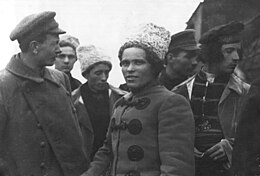
| Part of a series on |
| Anarchism |
|---|
 |
Anarchism in Ukraine has its roots in the democratic and egalitarian organization of the Zaporozhian Cossacks, who inhabited the region up until the 18th century. Philosophical anarchism first emerged from the radical movement during the Ukrainian national revival, finding a literary expression in the works of Mykhailo Drahomanov, who was himself inspired by the libertarian socialism of Pierre-Joseph Proudhon. The spread of populist ideas by the Narodniks also lay the groundwork for the adoption of anarchism by Ukraine's working classes, gaining notable circulation in the Jewish communities of the Pale of Settlement.
By the outbreak of the 1905 Revolution, a specifically anarchist movement had risen to prominence in Ukraine. The ideas of anarcho-communism, anarcho-syndicalism and individualist anarchism all took root in Ukrainian revolutionary circles, with syndicalism itself developing a notably strong hold in Odesa, while acts of anarchist terrorism by cells such as the Black Banner became more commonplace. After the revolution was suppressed, Ukrainian anarchism began to reorganize itself, culminating in the outburst following the February Revolution, when Nestor Makhno returned to the country and began to organize among the peasantry.
Ukraine became a stronghold of anarchism during the revolutionary period, acting as a counterweight to Ukrainian nationalism, Russian imperialism and Bolshevism. The Revolutionary Insurgent Army of Ukraine (RIAU), led by Makhno, carved out an anarchist territory in the south-east of the country, centered in the former cossack lands of Zaporizhzhia. By 1921, the Ukrainian anarchist movement was defeated by the Bolsheviks, who established the Ukrainian Soviet Socialist Republic in its place.
Anarchism experienced a brief resurgence in Ukraine during the time of the New Economic Policy, but was again defeated following the rise of totalitarianism under the rule of Joseph Stalin. Further expressions of anarchism existed in the breach of Soviet Ukrainian history, before finally reemerging onto the public sphere following the dissolution of the Soviet Union. In the 21st century, the Ukrainian anarchist movement has experienced a resurgence, itself coming into conflict with the rising far-right following Euromaidan.
© MMXXIII Rich X Search. We shall prevail. All rights reserved. Rich X Search
